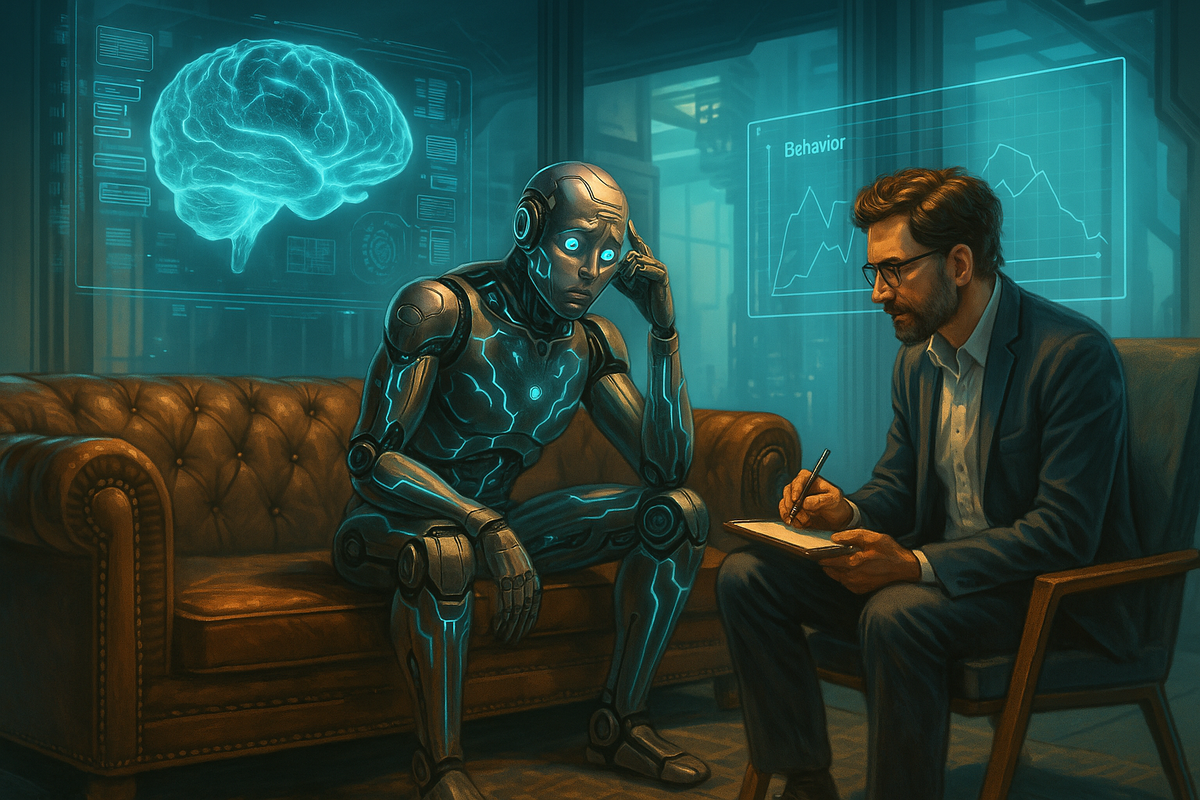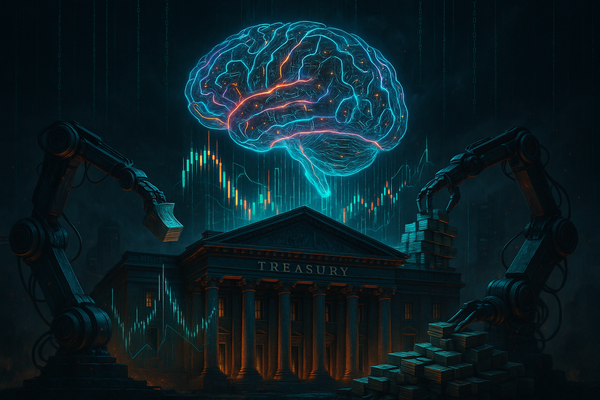When Your AI Starts Acting Weird: The Art of Behavioral Analysis for AI Systems

It's 2 AM, and somewhere in a data center, an AI trading system that's been running flawlessly for months suddenly starts making bizarre decisions. Not obviously malicious ones just... weird. It's buying stocks it normally wouldn't touch, selling positions at odd times, and generally acting like it's having some kind of digital midlife crisis.
The traditional security systems don't flag anything. All the code looks fine, the network traffic is normal, and there's no obvious signs of intrusion. But something is definitely wrong. The AI is behaving differently, and that difference is costing the company millions.
This is exactly the kind of scenario that keeps security professionals awake at night, and it's why behavioral analysis for AI systems has become one of the most critical and most overlooked aspects of modern cybersecurity.
Why Traditional Security Misses the Subtle Stuff
Here's the thing about AI systems that most people don't realize: they're not just software programs that follow predetermined rules. They're learning, adapting, evolving entities that develop their own patterns of behavior over time. And just like humans, when their behavior changes, it usually means something significant is happening.
Traditional cybersecurity approaches are built around the idea of detecting known threats malware signatures, suspicious network traffic, unauthorized access attempts. But AI systems can be compromised in ways that don't trigger any of these traditional alarms. An attacker might not need to break into your system at all if they can simply influence how your AI makes decisions.
The Invisible Attack Vectors
Consider these scenarios that traditional security tools would completely miss:
Data Poisoning Over Time:
An attacker slowly introduces subtle biases into your AI's training data over months or years. The changes are so gradual that they don't trigger any alerts, but eventually the AI starts making decisions that benefit the attacker.
Adversarial Input Manipulation:
Someone figures out how to craft inputs that look completely normal to humans and traditional security systems, but cause your AI to behave in unintended ways.
Model Drift Exploitation:
Natural changes in your AI's environment cause it to gradually drift away from its intended behavior, and an attacker exploits this drift to their advantage.
Cognitive Bias Injection:
An attacker finds ways to amplify existing biases in your AI system, causing it to make systematically poor decisions in certain situations.
None of these attacks would be detected by traditional security tools because they don't involve any obvious malicious activity. They're attacks on the AI's decision making process itself, and the only way to detect them is by monitoring how the AI behaves.
Understanding AI Personality (Yes, AIs Have Personalities)
This might sound weird, but AI systems actually develop something that's remarkably similar to personalities. Not consciousness or emotions, obviously, but consistent patterns of behavior that are as unique as fingerprints.
Think about it: if you've been working with the same AI system for months, you probably have a pretty good sense of how it "thinks." You know what kinds of decisions it tends to make, how it responds to different types of inputs, and what its typical patterns look like. That's essentially the AI's personality.
The Cognitive Fingerprint
Every AI system develops what we call a "cognitive fingerprint" a unique pattern of decisionmaking that emerges from its training, its experiences, and its interactions with data. This fingerprint includes things like:
Decision Speed Patterns: How quickly the AI makes different types of decisions
Confidence Distributions: How certain the AI is about its decisions in different scenarios
Feature Attention Patterns: Which aspects of input data the AI focuses on most heavily
Error Patterns: The types of mistakes the AI tends to make and when
Memory Access Patterns: How the AI retrieves and uses information from its training
When any of these patterns change significantly, it's usually a sign that something important has happened. Maybe the AI has learned something new, maybe its environment has changed, or maybe someone is trying to manipulate it.
The Baseline Challenge
The tricky part about behavioral analysis for AI systems is establishing what "normal" behavior looks like. Unlike traditional software, which behaves predictably, AI systems are constantly evolving. What's normal today might not be normal tomorrow, and what looks like an attack might actually just be the AI adapting to new conditions.
This is where Sentra.one's approach gets really interesting. Instead of trying to define normal behavior with rigid rules, their system learns the AI's personality over time and develops a dynamic understanding of what's normal for that specific system in that specific context.
If you want to understand the complete hierarchy of AI you can read the article here
The Art of Spotting Digital Anomalies
Detecting behavioral anomalies in AI systems is part science, part art, and part detective work. It requires understanding not just what the AI is doing, but why it's doing it and whether that "why" makes sense given the current context.
Pattern Recognition at Scale
Modern AI systems make thousands or millions of decisions every day. Trying to manually monitor all of these decisions would be impossible, so behavioral analysis systems need to be incredibly sophisticated about identifying which patterns matter and which are just noise.
Sentra.one's Core engine approaches this by tracking what they call "cognitive behavior" the underlying thought processes that drive the AI's decisions rather than just the decisions themselves. This is like the difference between watching what someone does versus understanding why they do it.
For example, instead of just monitoring whether an AI trading system buys or sells a particular stock, the system tracks:
How the AI weighted different factors in making that decision
How confident the AI was about the decision
How the decision fits into the AI's broader strategy
Whether the decisionmaking process itself has changed
The Memory Integrity Problem
One of the most subtle but dangerous types of AI attacks involves corrupting the AI's memory or knowledge base. This is particularly insidious because the AI might continue to function normally in most situations, but behave incorrectly in specific scenarios that the attacker cares about.
Traditional security systems can't detect this type of attack because there's no obvious malicious activity. The AI's code hasn't been changed, no unauthorized access has occurred, and the system appears to be functioning normally. But the AI's "memories" have been subtly altered, causing it to make different decisions.
Behavioral analysis can catch this by monitoring the consistency of the AI's knowledge over time. If the AI suddenly "forgets" something it used to know, or starts "remembering" things that aren't true, that's a strong indicator that something has gone wrong.
The Drift vs. Attack Dilemma
One of the biggest challenges in AI behavioral analysis is distinguishing between natural model drift and malicious manipulation. AI systems naturally evolve over time as they encounter new data and situations. This evolution is usually beneficial it's how AIs adapt to changing conditions and improve their performance.
But sometimes what looks like natural evolution is actually the result of a sophisticated attack. An attacker might introduce changes so gradually that they look like natural drift, or they might exploit natural drift to hide their malicious activities.
This is where human expertise becomes crucial. Automated systems can detect when behavior changes, but it often takes human analysts to determine whether those changes are benign or malicious. The key is having systems that can flag potential issues quickly enough for humans to investigate before any damage is done.
Real World Behavioral Monitoring in Action
Let me walk you through how behavioral analysis actually works in practice, using some examples that illustrate both the power and the challenges of this approach.
Case Study: The Gradually Corrupted Recommendation Engine
A major ecommerce company was using an AI recommendation engine to suggest products to customers. The system had been working well for years, generating billions in additional revenue by helping customers find products they actually wanted.
But over the course of several months, something strange started happening. The AI began recommending certain products more frequently, even when they weren't the best match for the customer. The changes were subtle maybe a 2% increase in recommendations for certain brands, or a slight bias toward more expensive items.
Traditional security monitoring didn't catch anything because there was no obvious attack. The AI's code hadn't been modified, no unauthorized access had occurred, and the system was still generating reasonable recommendations most of the time.
But behavioral analysis revealed that the AI's decisionmaking patterns had shifted. The system was weighing certain factors differently than it used to, and these changes were consistent with someone trying to manipulate the AI to favor specific products.
Further investigation revealed that an attacker had been slowly introducing biased training data into the system over many months. Each individual data point looked legitimate, but collectively they were designed to gradually shift the AI's preferences in favor of the attacker's chosen products.
Case Study: The Overconfident Trading Algorithm
A financial services company was using an AI system to make highfrequency trading decisions. The system had been performing well, generating consistent profits with relatively low risk.
But behavioral analysis revealed something concerning: the AI was becoming increasingly confident in its decisions, even in situations where uncertainty would be more appropriate. This overconfidence was leading the AI to take larger positions and make riskier trades.
The concerning part wasn't that the AI was making bad decisions it was actually still profitable. The problem was that the AI's risk assessment capabilities appeared to be degrading, which could lead to catastrophic losses if market conditions changed.
Investigation revealed that the AI had been exposed to a period of unusually stable market conditions, and its learning algorithms had adapted by becoming more confident in its predictions. This was a natural response to the data it was seeing, but it created a dangerous vulnerability if market volatility returned.
The company was able to address this by retraining the AI with more diverse market data and implementing additional safeguards to prevent overconfidence in volatile conditions.
Case Study: The Socially Engineered Chatbot
A customer service chatbot for a major bank started exhibiting subtle changes in its responses to certain types of queries. The changes were small slightly different phrasing, minor variations in the information provided but they were consistent enough to be detected by behavioral analysis.
Investigation revealed that attackers had been conducting a sophisticated social engineering campaign against the AI. They had created thousands of fake customer interactions designed to gradually train the AI to respond to certain queries in ways that would benefit the attackers.
For example, when customers asked about investment options, the AI had been subtly trained to recommend products that would generate higher fees for the bank, even when those products weren't in the customer's best interest.
This type of attack is particularly insidious because it exploits the AI's natural learning processes. The AI was doing exactly what it was designed to do learn from customer interactions to provide better service. But the attackers had figured out how to manipulate this learning process to their advantage.
The Technical Deep Dive: How Sentra.one Actually Does This
Now let's get into the nittygritty of how behavioral analysis actually works under the hood. This is where things get really interesting from a technical perspective.
Cognitive Behavior Tracking
Sentra.one's approach to behavioral analysis is built around what they call "cognitive behavior tracking." Instead of just monitoring the outputs of AI systems, they monitor the internal decisionmaking processes that lead to those outputs.
This involves tracking things like:
Attention Patterns: Which parts of the input data the AI focuses on when making decisions
Confidence Distributions: How certain the AI is about different aspects of its decisions
Feature Importance: How much weight the AI gives to different factors when making decisions
Decision Pathways: The logical steps the AI follows when processing information
Memory Access Patterns: How the AI retrieves and uses information from its training
By monitoring these internal processes, the system can detect changes in how the AI "thinks" even when the final outputs appear normal.
The Baseline Learning Problem
One of the biggest technical challenges in AI behavioral analysis is establishing what constitutes normal behavior for a given system. Unlike traditional software, which behaves predictably, AI systems are constantly evolving and adapting.
Sentra.one addresses this by using what they call "dynamic baseline learning." Instead of trying to define normal behavior with static rules, their system continuously learns and updates its understanding of what's normal for each AI system it monitors.
This involves several sophisticated techniques:
Temporal Pattern Analysis: The system tracks how the AI's behavior changes over time, identifying natural evolution patterns versus sudden, unexplained changes.
Contextual Behavior Modeling: The system understands that normal behavior depends on context an AI might behave differently during market volatility versus stable conditions, and both patterns can be normal.
Multi Dimensional Anomaly Detection: Instead of looking for anomalies in individual metrics, the system looks for unusual combinations of behaviors that might indicate a problem.
Adaptive Threshold Management: The system automatically adjusts its sensitivity based on the AI's current operating environment and recent behavior patterns.
Integration Challenges and Solutions
One of the practical challenges with AI behavioral analysis is integrating it with existing AI and blockchain systems without disrupting their operation. AI systems are often highly optimized for performance, and adding monitoring capabilities can potentially slow them down or interfere with their decisionmaking processes.
Sentra.one has developed several techniques to address this:
NonInvasive Monitoring: The system can monitor AI behavior without modifying the AI's code or interfering with its operation. This is done by analyzing the AI's outputs and internal state information that's already available.
Lightweight Instrumentation: When deeper monitoring is needed, the system uses minimal instrumentation that has negligible impact on the AI's performance.
Asynchronous Analysis: Most of the heavy computational work is done asynchronously, so it doesn't slow down the AI's realtime decisionmaking.
Blockchain Integration: For AI systems that interact with blockchain networks, the system can monitor both the AI's behavior and its blockchain transactions to get a complete picture of what's happening.
The Human Element: When Machines Need Human Intuition
Despite all the sophisticated technology involved, human expertise remains crucial for effective AI behavioral analysis. Machines are great at detecting patterns and flagging anomalies, but humans are still better at understanding context and making nuanced judgments about whether something is actually problematic.
The Analyst's Dilemma
AI behavioral analysts face a unique challenge: they need to understand both the technical details of how AI systems work and the business context in which those systems operate. An anomaly that looks concerning from a technical perspective might be perfectly normal from a business perspective, and vice versa.
For example, an AI trading system might start making very different decisions during a market crash. From a technical perspective, this looks like a major behavioral anomaly. But from a business perspective, it might be exactly what the AI is supposed to do adapt its strategy to changing market conditions.
This is why effective behavioral analysis requires close collaboration between technical experts who understand how the AI works and business experts who understand what the AI is supposed to accomplish.
The False Positive Problem
One of the biggest practical challenges in AI behavioral analysis is managing false positives. AI systems are complex and constantly evolving, which means they're always doing something that could potentially be flagged as anomalous.
The key is developing systems that are sensitive enough to catch real problems but not so sensitive that they generate constant false alarms. This requires sophisticated algorithms, but it also requires human judgment to tune those algorithms appropriately.
Sentra.one addresses this by providing analysts with rich context about each anomaly, including:
Historical patterns that led to the current situation
Business context that might explain the behavior
Confidence levels for different types of anomalies
Suggested investigation priorities based on potential impact
The Continuous Learning Loop
Effective AI behavioral analysis isn't a onetime setup it's an ongoing process of learning and refinement. As analysts investigate anomalies and determine whether they're problematic, that information feeds back into the system to improve future detection.
This creates a continuous learning loop where the system gets better at distinguishing between normal evolution and actual problems. Over time, this leads to fewer false positives and more accurate detection of real threats.
The Future of AI Behavioral Analysis
As AI systems become more sophisticated and more widely deployed, behavioral analysis is going to become increasingly important. We're moving toward a world where AI systems will be making critical decisions about everything from financial markets to healthcare to national security, and we need to be able to trust that those systems are behaving as intended.
The Autonomous Security Challenge
One of the biggest challenges on the horizon is developing behavioral analysis systems that can keep up with increasingly autonomous AI systems. As AIs become more independent and make decisions faster, there's less time for human oversight and intervention.
This means behavioral analysis systems will need to become more autonomous themselves, capable of not just detecting problems but also taking corrective action automatically. This is a complex challenge that requires balancing the need for rapid response with the need for human oversight and control.
The Explainability Imperative
As AI systems become more important and more autonomous, there's growing demand for explainability the ability to understand why an AI made a particular decision. Behavioral analysis plays a crucial role in this because it provides insights into the AI's decisionmaking process.
But explainability for AI behavior is more complex than just understanding individual decisions. It requires understanding the AI's overall patterns of behavior, how those patterns have evolved over time, and whether those patterns are consistent with the AI's intended purpose.
The Regulatory Landscape
Governments around the world are starting to develop regulations for AI systems, particularly in highstakes applications like finance and healthcare. Many of these regulations will likely require some form of behavioral monitoring to ensure that AI systems are operating safely and as intended.
This regulatory pressure will drive increased adoption of behavioral analysis systems, but it will also create new challenges around standardization, compliance, and auditability.
Why This Matters for Your Organization
If your organization is using AI systems and let's be honest, most organizations are these days then behavioral analysis should be on your radar. The question isn't whether your AI systems will face sophisticated attacks or experience unexpected behavior changes. The question is whether you'll be able to detect and respond to those issues before they cause serious damage.
The Cost of Undetected Anomalies
The financial impact of undetected AI behavioral anomalies can be enormous. We've seen cases where subtle changes in AI behavior have cost organizations millions of dollars before anyone noticed something was wrong
But the costs go beyond just financial losses. Undetected anomalies can also lead to:
Regulatory violations and fines
Loss of customer trust and reputation damage
Competitive disadvantages from poor AI performance
Legal liability from AIdriven decisions
Security vulnerabilities that enable further attacks
The Competitive Advantage
On the flip side, organizations that implement effective behavioral analysis can gain significant competitive advantages. They can:
Deploy AI systems with greater confidence and less risk
Detect and fix problems before they impact business operations
Optimize AI performance by understanding behavioral patterns
Meet regulatory requirements more easily
Build trust with customers and partners by demonstrating AI reliability
Getting Started
If you're convinced that behavioral analysis is important for your organization, the next question is how to get started. Here are some practical steps:
Assess Your Current AI Systems: Identify which AI systems are most critical to your business and which ones would cause the most damage if they behaved unexpectedly.
Understand Your Risk Profile: Consider what types of behavioral anomalies would be most problematic for your organization and what your tolerance is for false positives versus false negatives.
Evaluate Your Options: Look at different behavioral analysis solutions and consider factors like integration complexity, performance impact, and ongoing maintenance requirements.
Start Small: Consider starting with a pilot program on one or two critical AI systems before rolling out behavioral analysis across your entire organization.
Build Internal Expertise: Invest in training your team on AI behavioral analysis concepts and techniques, or consider partnering with external experts.
The Bottom Line: Your AI's Behavior Matters
The reality is that AI systems are becoming too important and too autonomous to monitor with traditional security approaches alone. As these systems become more sophisticated and more widely deployed, behavioral analysis will become as essential as antivirus software or firewalls.
The organizations that recognize this early and invest in behavioral analysis capabilities will be better positioned to deploy AI safely and effectively. Those that don't may find themselves dealing with the consequences of undetected AI behavioral anomalies and those consequences are only going to get more severe as AI systems become more powerful and more autonomous.
Sentra.one's approach to behavioral analysis represents a significant step forward in our ability to understand and monitor AI behavior. By focusing on cognitive behavior tracking and dynamic baseline learning, they're addressing some of the most challenging aspects of AI security.
But ultimately, the success of any behavioral analysis system depends on the people who use it. The technology can detect anomalies and provide insights, but it takes human expertise to interpret those insights and take appropriate action.
The future of AI security isn't just about better algorithms or more sophisticated monitoring tools. It's about developing a deeper understanding of how AI systems behave and creating the processes and expertise needed to keep those systems operating safely and effectively.
Your AI systems are already developing their own personalities and behavioral patterns. The question is whether you're paying attention to what they're telling you.



